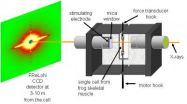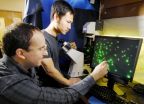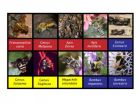Distribution of cancers in the HIV/AIDS population is shifting
2011-04-12
As treatments for HIV/AIDS improve and patients are living longer, the distribution of cancers in this population has undergone a dramatic shift in the United States. While cases of the types of cancer that have been associated with AIDS progression have decreased, cases of other types of cancer are on the rise. These results, reported by scientists from the National Cancer Institute (NCI), part of the National Institutes of Health, and the Centers for Disease Control and Prevention, were published online April 11, 2011, in the Journal of the National Cancer Institute.
The ...
UCSF study on multitasking reveals switching glitch in aging brain
2011-04-12
Scientists at the University of California, San Francisco have pinpointed a reason older adults have a harder time multitasking than younger adults: they have more difficulty switching between tasks at the level of brain networks.
Juggling multiple tasks requires short-term, or "working," memory – the capacity to hold and manipulate information in the mind for a period of time. Working memory is the basis of all mental operations, from learning a friend's telephone number, and then entering it into a smart phone, to following the train of a conversation, to conducting ...
Brighter Future for Planet is The Goal as Sheraton Sharm El Sheikh Goes Dark for Earth Hour 2011
2011-04-12
By spending an hour in the dark on March 26th, Sheraton Sharm El Sheikh joined millions around the world to send a powerful message about a brighter future for the planet.
Sheraton Sharm El Sheikh turned off its lights in observance of Earth Hour, the global environmental awareness event created by the World Wildlife Fund (WWF). Last year, Earth Hour 2010 became the biggest Earth Hour ever. A record 128 countries and territories joined the global display of climate action. Iconic buildings and landmarks from Asia Pacific to Europe and Africa to the Americas switched ...
Combined use of 3 markers for kidney disease may help predict risk of kidney failure, death
2011-04-12
Combining the chronic kidney disease markers of creatinine-based estimated glomerular filtration rate and urine albumin-to-creatinine ratio with the biomarker cystatin C was associated with improved prediction of end-stage kidney disease and all-cause death, according to a study that will appear in the April 20 issue of JAMA. The study is being published early online to coincide with its presentation at the World Congress of Nephrology.
Chronic kidney disease (CKD) is currently defined as certain levels of creatinine-based estimated glomerular filtration rate (GFR) or ...
Routine lab test data predicts progression to kidney failure for chronic kidney disease patients
2011-04-12
A prediction model that included data on measures of several routinely obtained laboratory tests including blood levels of calcium, phosphate and albumin accurately predicted the short-term risk of kidney failure for patients with moderate to severe chronic kidney disease, according to a study that will appear in the April 20 issue of JAMA. The study is being published early online to coincide with its presentation at the World Congress of Nephrology.
"An estimated 23 million people in the United States (11.5 percent of the adult population) have chronic kidney disease ...
Evidence lacking for efficacy of memantine in treating mild Alzheimer's disease
2011-04-12
An analysis of studies involving the drug memantine finds a lack of
evidence for benefit when the drug is used to treat patients with mild
Alzheimer disease, according to a report posted online today that will
appear in the August print issue of Archives of Neurology, one of the
JAMA/Archives journals.
"Memantine, indicated for moderate to severe Alzheimer disease (AD), is frequently prescribed off-label [for uses other than those approved by the FDA] either alone or with a cholinesterase inhibitor for mild AD and mild cognitive impairment," the authors write as background ...
Automatic Network Backup Features in a New Version of Handy Backup by Novosoft
2011-04-12
Novosoft, an international software development and IT consultancy company, announced the release of a new version of Handy Backup. The program presents features (automatic registration and remote installation over Active Directory among others) to help system administrators configure backup plans for windows networks.
"Want me to tell you a secret of success in software development? I personally doubt there are "magic" formulas, but here is a thing that proved to be solely efficient: explore various applications of your concepts. Take Handy Backup. One of the major ...
Long-term use of antibiotic to treat acne not associated with increased bacterial resistance
2011-04-12
The prolonged use of tetracycline antibiotics commonly used to treat acne was associated with a reduced prevalence of StaphylococcuS. aureus bacteria and was not associated with increased resistance to the tetracycline antibiotics, according to a report posted online today that will appear in the August print issue of Archives of Dermatology, one of the JAMA/Archives journals.
StaphylococcuS. aureus is found in both hospital and community settings. "While S. aureus colonizes the skin, it can also be responsible for localized cutaneous infections and life-threatening systemic ...
Le Meridien Amman and Starwood Hotels and Resorts Ended the Environmental and Charity Campaign with Magnificent Results
2011-04-12
Le Meridien Amman and Starwood Hotels & Resorts achieved distinguished results from its latest Charity and Environmental campaign that was launched in Middle East region as of November 1st, 2010 and lasted on 31st of January 2011. The aim of the campaign was to protect the environment and raise money to provide wheel chairs to children with disabilities. Le Meridien Amman has donated the wheelchair which was bought from this initiative to Al Hussein Society for the Habilitation and Rehabilitation of the Physically Challenged.
Le Meridien Amman and more than 14 Starwood ...
Scientists flex their muscles to solve an old problem
2011-04-12
In a famous experiment first performed more than 220 years ago, Italian physician Luigi Galvani discovered that the muscles of a frog's leg twitch when an electric voltage is applied. An international group of scientists from Italy, the UK and France has now brought this textbook classic into the era of nanoscience. They used a powerful new synchrotron X-ray technique to observe for the first time at the molecular scale how muscle proteins change form and structure inside an intact and contracting muscle cell. The results are published in the 11 April 2011 issue of the ...
JetBoarder International Announces Worlds First Carbon Fibre JetBoarder Due for Release in July 2011
2011-04-12
The new model, to be named the 'Stealth', will be 15 Kg lighter, more rigid and able to handle more aggressive riding due to its hull construction.
The idea to produce the Carbon fibre model was the brainchild of Chris Kanyaro. The initial concept being to lighten the overall weight of the current Sports Model. The new Stealth model will be much lighter, meaning more Horse Power, we expect an extra 5 - 10 K / Hr, better fuel consumption and ride.
We are still in the early production phase but are due to have our prototype ready for testing in the coming month.
Launch ...
Study provides new way to classify E. coli bacteria and test for fecal contamination
2011-04-12
The meaning of the standard fecal coliform test used to monitor water quality has been called into question by a new study that identified sources of Escherichia coli bacteria that might not indicate an environmental hazard.
Fecal pollution of surface waters is measured by the concentration of E. coli bacteria in the water because E. coli is believed to live only in the intestines and waste of humans and other warm-blooded animals, and quickly die outside its host. The presence of E. coli in water also serves as a marker for other potentially more harmful organisms that ...
Black Top Shopping.com Goes for the Gold to Bring the Power of the Coupon to Fashionistas and Emerging Designers
2011-04-12
The fashion industry has stood up and taken notice of the power behind these statistics. It's no secret that people like to save money whenever they can and fashion shoppers are no exception. While there are thousands of bargains that are highly advertised, many more are available exclusively through representatives such as Black Top Shopping. Today, the company announced the launch of registration at http://blacktopshopping.com for their members rewards program the "Gold Card Fashion Pass" which will give them access to these private sales starting April 19th. With more ...
Cancer burden shifts for people with HIV/AIDS
2011-04-12
The number of cancers and the types of cancers among people living with AIDS in the U.S. have changed dramatically during the 15-year period from 1991-2005, according to an article published online April 11th in the Journal of the National Cancer Institute.
It is known that HIV-infected patients face an increased risk of Kaposi sarcoma, non-Hodgkin lymphoma, and cervical cancer--the AIDS-defining cancers--and that the incidence of these cancers dropped when highly active anti-retroviral therapy (HAART) became available in the mid-1990s. People living with HIV and AIDS ...
"Judgmentless Gospel" Is No Gospel at All, Author Says, Refuting Rob Bell's Controversial New Book "Love Wins"
2011-04-12
Will only a few select people make it to heaven? Will billions of people spend eternity in hell?
Many people are angry with God for allowing evil and suffering to exist in this world, and yet they are also angry with the idea of God as judge. You can't have it both ways, says Trevin Wax, associate pastor of First Baptist Church in Shelbyville, Tenn., and author of the new book Counterfeit Gospels: Rediscovering the Good News in a World of False Hope.
"If you expect God to do something about the evil in this world, then you want God to judge," Wax explains.
The ...
Hair styles may contribute to scarring hair loss in African-American women
2011-04-12
Hair grooming practices, such as braids and weaves, as well as inflammation in the form of bacterial infection, may be contributing to the development of scarring hair loss in African American women, according to a report posted online today that will appear in the August print issue of Archives of Dermatology, one of the JAMA/Archives journals.
"Central centrifugal cicatricial alopecia (CCCA) is a term coined by the North American Hair Research Society to describe a scarring hair loss, centered on the vertex of the scalp, that spreads peripherally," the authors write ...
High levels of vitamin D appear to lower risk of age-related macular degeneration in young women
2011-04-12
High levels of vitamin D in the bloodstream appear to be associated with a decreased risk of developing early age-related macular degeneration among women younger than 75 years, according to a report in the April issue of Archives of Ophthalmology, one of the JAMA/Archives journals.
"Age-related macular degeneration (AMD), a chronic, late-onset disease that results in degeneration of the macula, is the leading cause of adult irreversible vision loss in developed countries," the authors write as background information in the article. "Age-related macular degeneration affects ...
A Cloud Hosting Review Site Helps Businesses Get the Best Cloud Experience - CloudHostingReviewer.com Leads the Way
2011-04-12
The Future of Hosting Lies Not in the Sky but in the Clouds
The terms Cloud Computing and Cloud Hosting may not be very new for anyone related to the field. Experts are of the opinion that these terms define the future of Computer science and technology. In Cloud hosting, a website is not limited to a single server. A cloud hosted site is run on on multiple servers as if they were one server. Access to multiple servers gives nearly unlimited processing power and therefore a better experience.
CloudHostingReviewer.com is a website that offers in-depth reviews of top ...
Study finds physicians recommend different treatments for patients than they choose for themselves
2011-04-12
The act of making a recommendation appears to change the way physicians think regarding medical choices, and they often make different choices for themselves than what they recommend to patients, according to a survey study published in the April 11 issue of Archives of Internal Medicine, one of the JAMA/Archives journals.
"Patients facing difficult decisions often ask physicians for recommendations," the authors write as background information in the study. "However, little is known regarding the ways that physicians' decisions are influenced by the act of making a recommendation."
Peter ...
Genetic study offers insight into the social lives of bees
2011-04-12
CHAMPAIGN, Ill. — Most people have trouble telling them apart, but bumble bees, honey bees, stingless bees and solitary bees have home lives that are as different from one another as a monarch's palace is from a hippie commune or a hermit's cabin in the woods. A new study of these bees offers a first look at the genetic underpinnings of their differences in lifestyle.
The study focuses on the evolution of "eusociality," a system of collective living in which most members of a female-centric colony forego their reproductive rights and instead devote themselves to specialized ...
Intense Peru Entices Travelers to Tour Machu Picchu 100 Years After Its Discovery
2011-04-12
Intense Peru, experts in designing unique travel experiences to Peru, recently announced a 10% savings on all Machu Picchu tours in recognition of the 100 year anniversary of the discovery of Lost City of the Incas by American archaeologist Hiram Bingham. Every year an increasing number of travelers come from different parts of the world to admire the Historic Sanctuary of Machu Picchu. Some travelers have little information and some others not only are well prepared but fill their tour guides with enthusiastic comments and questions. And the truth is that no matter how ...
Protein could improve recovery from heart attacks
2011-04-12
Angiogenesis, the development of new blood vessels, is required during embryonic development and wound healing, as well as during disease processes such as tumor growth. The signals that direct angiogensis are incompletely understood, but could represent novel targets for the development of therapies that promote or inhibit this process.
In this paper, Young-Guen Kwon and colleagues, of Yonsei University in Seoul, Korea, investigated the role of two related proteins- DKK1 and DKK2- in angiogenesis. These proteins are known to have similar functions in inhibiting a particular ...
Physicists discover new way to visualize warped space and time
2011-04-12
PASADENA, Calif.—When black holes slam into each other, the surrounding space and time surge and undulate like a heaving sea during a storm. This warping of space and time is so complicated that physicists haven't been able to understand the details of what goes on—until now.
"We've found ways to visualize warped space-time like never before," says Kip Thorne, Feynman Professor of Theoretical Physics, Emeritus, at the California Institute of Technology (Caltech).
By combining theory with computer simulations, Thorne and his colleagues at Caltech, Cornell University, ...
Potato consumption in children's meals leads to higher overall diet quality
2011-04-12
Denver, CO., April 11, 2011 – Research to be presented this week at The Federation of American Societies for Experimental Biology (FASEB) Conference in Washington, D.C., demonstrates that consumption of white potatoes (non-fried) by children does not displace other vegetables from children's meals. In fact, meals that contain white potatoes contain more servings of other vegetables, and are significantly higher in potassium, fiber and vitamin C. Both potassium and fiber were identified as nutrients of concern in the 2010 Dietary Guidelines, released February 2011.
"Potatoes ...
Pistachios deliver weight management support, heart health benefits
2011-04-12
Washington, D.C., April 11, 2011 – In a first-of-its-kind study with nuts, randomized controlled-feeding research conducted by the Agricultural Research Service (ARS) of the United States Department of Agriculture (USDA) found that fat in pistachios may not be completely absorbed by the body. The findings indicate that pistachios may actually contain fewer calories per serving than originally thought – further validating pistachios as one of the lowest calorie nuts with 160 calories per 30 gram serving (approximately 1 ounce). The study was presented today at the Experimental ...
[1] ... [7445]
[7446]
[7447]
[7448]
[7449]
[7450]
[7451]
[7452]
7453
[7454]
[7455]
[7456]
[7457]
[7458]
[7459]
[7460]
[7461]
... [8708]
Press-News.org - Free Press Release Distribution service.




